This post comes from Ecoscenography
This post comes from Andrea Carr – a London based ecoscenographer, artist and co-founder of the ecostage pledge*. Andrea is passionate about investigating the creative potential of repurposing materials in ecological practice. Here she talks about her latest ecoscenography adventure: how discarded camping equipment from UK’s Reading Festival can be given a new life.
How can we inspire one another to make sustainable choices in the creative industries? What are some of the ways in which we can creatively flourish whilst addressing ecological concerns? These are just some of the questions that motivated me for the design of HOAX  Theatre’s  new production exploring mining and climate change.
 Loosely based on Jules Verne’s epic adventure, Journey to the Centre of the Earth, starting in Iceland, three ‘wunderkind’ Geo-Scientists (Flavia Bertum, Ayesha Tansey and Sabrina Manach) from ‘MyGeoCorpse Mining Corporation’ set off in search of precious minerals. As they drill down through the earth’s layers their machinery breaks down, finding themselves lost in the darkness. As panic ensues, they continue on foot, delving deeper into the collective unconscious they begin to unearth the complexities of climate change.
Loosely based on Jules Verne’s epic adventure, Journey to the Centre of the Earth, starting in Iceland, three ‘wunderkind’ Geo-Scientists (Flavia Bertum, Ayesha Tansey and Sabrina Manach) from ‘MyGeoCorpse Mining Corporation’ set off in search of precious minerals. As they drill down through the earth’s layers their machinery breaks down, finding themselves lost in the darkness. As panic ensues, they continue on foot, delving deeper into the collective unconscious they begin to unearth the complexities of climate change.
The brief for Journey to the Centre of the Earth was to design four layers of clothing for each Geo-Scientist. This was conceived as part of a series of dramaturgical revelations – with each layer progressing from extremities of cold (at the earths crust) to heat (at the core). Embracing the expedition spirit, I decided to use secondhand camping equipment for my concept. I utilised the particular characteristics (zips, padding and chrysalis shape) of sleeping bags as the first layer of the costume, so that it first appeared as if people are curled up asleep before transforming into unique expedition outfits. The idea was to also depict ideas of metamorphosis and evolution.
My first step to ethically sourcing camping equipment was to contact Julie’s Bicycle (a great resource and champion of sustainability and culture change), who alerted me to the fact that each year volunteers scour the campsites at Reading Festival, as part of the cleanup operation, recovering camping equipment left behind. So while HOAX went on a research and development residency to Fljotstunga Eco-Farm in Iceland (for an invaluable immersive experience exploring the terrain) I joined the volunteers salvage operation.
Perhaps I drew the shorter straw? On the way down to Reading (with Peter, my husband at the wheel) I fretted, “would there be enough sleeping bags left?†But, I need not have worried for nothing could have prepared me for what met my eyes as I stood looking over a sea, not of water, but of abandoned tents! Nevertheless, spirits were high as gloves were excitedly shared amongst the volunteers. I met the Scouts and people collecting for refugees at Calais (all generously providing tips of where the best equipment could be found). It was a pretty devastating sight to see so much discarded camping equipment – but not without hope. It was muddy and stinky (gloves being a must!) but so worth it. By the time my four hour slot was up the light was fading and we had retrieved over forty bags and nine tents, plus other camping bits and bobs for the set and costume design.
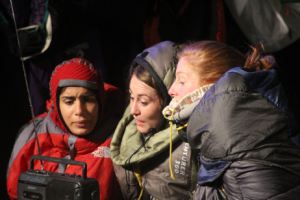 It is worth noting that camping equipment is made from synthetic textiles such as nylon, polyester and ripstop derived from the petro-chemical industries (which will take between 20 and 200 years to biodegrade). A sleeping bag is composed of three layers: outer shell (synthetic material), filing (feather or synthetic), lining (synthetic, fleece, silk or cotton), zips – (aluminum, metals, plastic), toggles and cord (plastic and cotton) and polyester sewing thread. It is estimated that 45,000 tents are brought to Reading Festival with 13,500 abandoned at the end of the weekend. The cost of tents (£20) and sleeping bags (£10) has been cited as one of the causes and has changed the nature of camping from a ‘once in a life-time’ purchase to a throw away item.
It is worth noting that camping equipment is made from synthetic textiles such as nylon, polyester and ripstop derived from the petro-chemical industries (which will take between 20 and 200 years to biodegrade). A sleeping bag is composed of three layers: outer shell (synthetic material), filing (feather or synthetic), lining (synthetic, fleece, silk or cotton), zips – (aluminum, metals, plastic), toggles and cord (plastic and cotton) and polyester sewing thread. It is estimated that 45,000 tents are brought to Reading Festival with 13,500 abandoned at the end of the weekend. The cost of tents (£20) and sleeping bags (£10) has been cited as one of the causes and has changed the nature of camping from a ‘once in a life-time’ purchase to a throw away item.
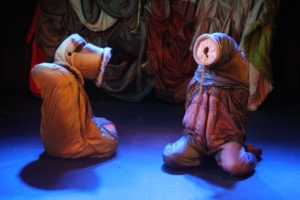 The good news is that Reading Festival in collaborative partnership with Julie’s Bicycle, Knowledge Transfer Network and other organisations are pioneering a new project to tackle campsite waste by testing festival-goers interest in services such as tent cleaning and packing away to encourage them to take it away.
The good news is that Reading Festival in collaborative partnership with Julie’s Bicycle, Knowledge Transfer Network and other organisations are pioneering a new project to tackle campsite waste by testing festival-goers interest in services such as tent cleaning and packing away to encourage them to take it away.
Returning from Reading, my flat soon filled with drying sleeping bags – it took 4 days from collection to being ready to use. In my studio, we undertook the wonderful and highly creative process of discovering ways of re-purposing the sleeping bags. This I did with help from my team (Central St Martins graduates: Harriet Fowler, Rosie Elliot-Dancs, Roisin Straver and Elisa Nader) and proved to be more challenging than we had anticipated. The materials had so many layers and surprisingly complex shapes. I believe that there is nothing that can give you a deeper appreciation of the resources that go into the production of an item than mindfully deconstructing it. Initiatives and ‘tear downs’ run by places such as FabLab, Hackerspaces, Makersspaces and Restart are great teachers of this process. Once you have experienced this (which I highly recommend!), it becomes increasing difficult to relegate things to the scrap heap. It is a highly insightful process.
I believe that there is nothing that can give you a deeper appreciation of the resources that go into the production of an item than mindfully deconstructing it. Initiatives and ‘tear downs’ run by places such as FabLab, Hackerspaces, Makersspaces and Restart are great teachers of this process. Once you have experienced this (which I highly recommend!), it becomes increasing difficult to relegate things to the scrap heap. It is a highly insightful process.
There is always a balancing act to consider in any of these ventures – the use of fuel, water and electricity as well as extra support and time. Eco-driven initiatives can take longer than going out and making a direct purchase or even making something from scratch. A deeper understanding and reframing of design and production practices is of vital importance. The materials may cost less, in this case, the total for the van hire, fuel and eco-laundry liquid was £56.00 but the labour was more intense. I believe this needs to be reflected in how budgets are calculated and people’s skills and time valued.
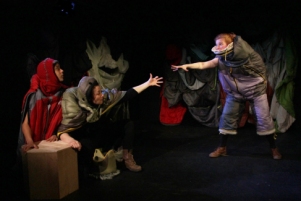 My journey has just begun with HOAX and there will be lots more scope for exciting ecological and creative solutions to inspire the next stages of the design. A work-in-progress presentation of Journey to the Centre of the Earth took place at the Pleasance Theatre, London in October 2015 (as part of ArtCOP21) where I also shared this story as part of a post-show Q&A. The show was a great success, paving the way for a full-length production planned for 2016. My costume also had another outing (worn by Flavia Bertum) at the Omnibus Perception Festival – Voice INTERROBANG: ARTCOP21 opened by Vivienne Westward – where I was given another opportunity to say a few words about the project. As Vivienne snapped a picture of my costume, I did wonder whether it might inspire her next collection!
My journey has just begun with HOAX and there will be lots more scope for exciting ecological and creative solutions to inspire the next stages of the design. A work-in-progress presentation of Journey to the Centre of the Earth took place at the Pleasance Theatre, London in October 2015 (as part of ArtCOP21) where I also shared this story as part of a post-show Q&A. The show was a great success, paving the way for a full-length production planned for 2016. My costume also had another outing (worn by Flavia Bertum) at the Omnibus Perception Festival – Voice INTERROBANG: ARTCOP21 opened by Vivienne Westward – where I was given another opportunity to say a few words about the project. As Vivienne snapped a picture of my costume, I did wonder whether it might inspire her next collection!
I personally find it deeply fulfilling when imagination can find creative expression within sustainable practices and this can be linked to helping build awareness around environmental issues – such as, the impact of camping equipment after festivals. While re-cycling and re-purposing was once the remit of ‘poor’ small-scale productions – driven mainly by necessity – production companies of all sizes are now embracing its potential, whether driven by economic or philanthropic concerns. Having witnessed the ‘re-branding’ of re-cycling over the years it is now time to accentuate its opportunities.
Andrea Carr is a scenographer, performance maker and artist interested in the intersection between different disciplines. She is part of a growing community of designers exploring the emerging paradigm of ecoscenography incorporating sustainable practices and  developing ecological projects. She is also a practicing  artist.
*The ecostage pledge (launching in early December) is a new global initiative for the performing arts sector which aims to place ecological thinking at the heart of creative practice.  Join us on Facebook or follow us on Twitter for updates.
The post, Sleeping Bag Metamorphosis by Andrea Carr, appeared first on Ecoscenography.
———-
Ecoscenography.com has been instigated by designer Tanja Beer – a PhD candidate at the University of Melbourne, Australia, investigating the application of ecological design principles to theatre.
Tanja Beer is a researcher and practitioner in ecological design for performance and the creator of The Living Stage – an ecoscenographic work that combines stage design, permaculture and community engagement to create recyclable, biodegradable and edible performance spaces. Tanja has more than 15 years professional experience, including creating over 50 designs for a variety of theatre companies and festivals in Australia (Sydney Opera House, Melbourne International Arts Festival, Queensland Theatre Company, Melbourne Theatre Company, Arts Centre) and overseas (including projects in Vienna, London, Cardiff and Tokyo).
Since 2011, Tanja has been investigating sustainable practices in the theatre. International projects have included a 2011 Asialink Residency (Australia Council for the Arts) with the Tokyo Institute of Technology and a residency with the Royal Central School of Speech and Drama (London) funded by a Norman Macgeorge Scholarship from the University of Melbourne. In 2013, Tanja worked as “activist-in-residence†at Julie’s Bicycle (London), and featured her work at the 2013 World Stage Design Congress (Cardiff)
Tanja has a Masters in Stage Design (KUG, Austria), a Graduate Diploma in Performance Making (VCA, Australia) and is currently a PhD candidate at the University of Melbourne where she also teaches subjects in Design Research, Scenography and Climate Change. A passionate teacher and facilitator, Tanja has been invited as a guest lecturer and speaker at performing arts schools and events in Australia, Canada, the USA and UK. Her design work has been featured in The Age and The Guardian and can be viewed at www.tanjabeer.com
Go to MELD
Powered by WPeMatico




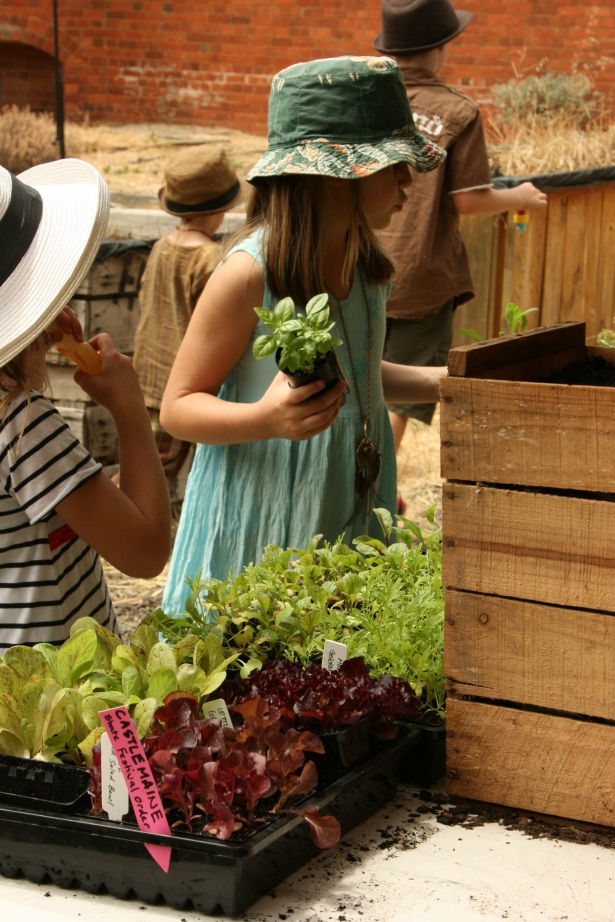 As the deadline of handing in my PhD draws closer, I’m excited about uncovering the potential of Ecoscenography. Here, I share a short summary of my research and the possibilities of contributive practice in the performing arts.Â
As the deadline of handing in my PhD draws closer, I’m excited about uncovering the potential of Ecoscenography. Here, I share a short summary of my research and the possibilities of contributive practice in the performing arts. 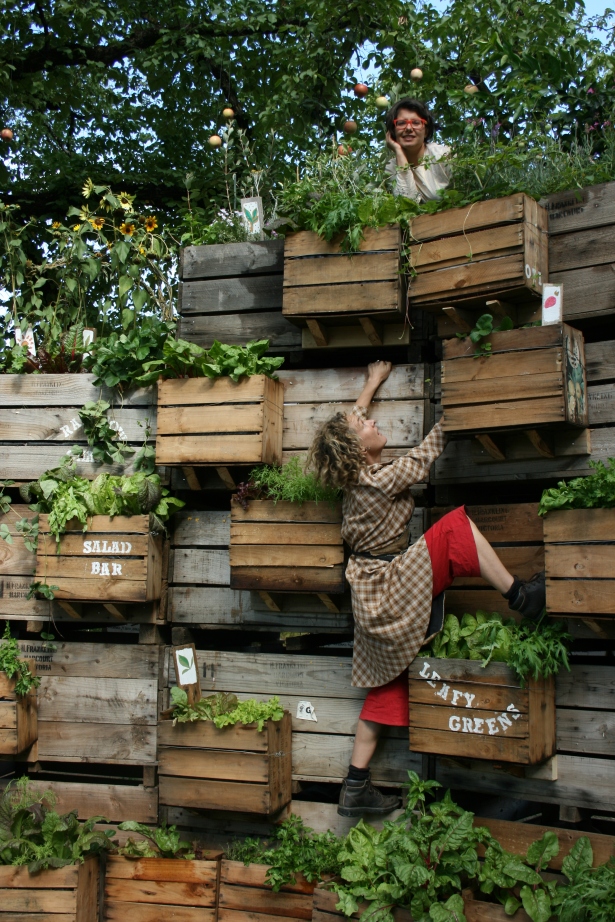 Since starting my candidature, a selection of my creative works have developed under the banner of The Living Stage – a global project that combines stage design, permaculture and community engagement to create recyclable, biodegradable and edible performance spaces. Part theatre, part garden and part food growing demonstration, The Living Stage considers ecological principles and environmental impact as opportunities rather than constraints: ethics that can illuminate, and be integral to aesthetics. At the end of the performances, my living stages are returned to the communities that helped grow them. Physical structures become garden beds and community spaces; plants become healthy food; and waste becomes compost. As each living stage evolves out of a direct response to the localities of site, ecology and community, no project is ever the same.
Since starting my candidature, a selection of my creative works have developed under the banner of The Living Stage – a global project that combines stage design, permaculture and community engagement to create recyclable, biodegradable and edible performance spaces. Part theatre, part garden and part food growing demonstration, The Living Stage considers ecological principles and environmental impact as opportunities rather than constraints: ethics that can illuminate, and be integral to aesthetics. At the end of the performances, my living stages are returned to the communities that helped grow them. Physical structures become garden beds and community spaces; plants become healthy food; and waste becomes compost. As each living stage evolves out of a direct response to the localities of site, ecology and community, no project is ever the same.
 Loosely based on Jules Verne’s epic adventure, Journey to the Centre of the Earth, starting in Iceland, three ‘wunderkind’ Geo-Scientists (Flavia Bertum, Ayesha Tansey and Sabrina Manach) from ‘MyGeoCorpse Mining Corporation’ set off in search of precious minerals. As they drill down through the earth’s layers their machinery breaks down, finding themselves lost in the darkness. As panic ensues, they continue on foot, delving deeper into the collective unconscious they begin to unearth the complexities of climate change.
Loosely based on Jules Verne’s epic adventure, Journey to the Centre of the Earth, starting in Iceland, three ‘wunderkind’ Geo-Scientists (Flavia Bertum, Ayesha Tansey and Sabrina Manach) from ‘MyGeoCorpse Mining Corporation’ set off in search of precious minerals. As they drill down through the earth’s layers their machinery breaks down, finding themselves lost in the darkness. As panic ensues, they continue on foot, delving deeper into the collective unconscious they begin to unearth the complexities of climate change. It is worth noting that camping equipment is made from synthetic textiles such as nylon, polyester and ripstop derived from the petro-chemical industries (which will take between 20 and 200 years to biodegrade). A sleeping bag is composed of three layers: outer shell (synthetic material), filing (feather or synthetic), lining (synthetic, fleece, silk or cotton), zips – (aluminum, metals, plastic), toggles and cord (plastic and cotton) and polyester sewing thread. It is estimated that 45,000 tents are brought to Reading Festival with 13,500 abandoned at the end of the weekend. The cost of tents (£20) and sleeping bags (£10) has been cited as one of the causes and has changed the nature of camping from a ‘once in a life-time’ purchase to a throw away item.
It is worth noting that camping equipment is made from synthetic textiles such as nylon, polyester and ripstop derived from the petro-chemical industries (which will take between 20 and 200 years to biodegrade). A sleeping bag is composed of three layers: outer shell (synthetic material), filing (feather or synthetic), lining (synthetic, fleece, silk or cotton), zips – (aluminum, metals, plastic), toggles and cord (plastic and cotton) and polyester sewing thread. It is estimated that 45,000 tents are brought to Reading Festival with 13,500 abandoned at the end of the weekend. The cost of tents (£20) and sleeping bags (£10) has been cited as one of the causes and has changed the nature of camping from a ‘once in a life-time’ purchase to a throw away item. The good news is that Reading Festival in collaborative partnership with Julie’s Bicycle,
The good news is that Reading Festival in collaborative partnership with Julie’s Bicycle,  I believe that there is nothing that can give you a deeper appreciation of the resources that go into the production of an item than mindfully deconstructing it. Initiatives and ‘tear downs’ run by places such as FabLab, Hackerspaces, Makersspaces and Restart are great teachers of this process. Once you have experienced this (which I highly recommend!), it becomes increasing difficult to relegate things to the scrap heap. It is a highly insightful process.
I believe that there is nothing that can give you a deeper appreciation of the resources that go into the production of an item than mindfully deconstructing it. Initiatives and ‘tear downs’ run by places such as FabLab, Hackerspaces, Makersspaces and Restart are great teachers of this process. Once you have experienced this (which I highly recommend!), it becomes increasing difficult to relegate things to the scrap heap. It is a highly insightful process. My journey has just begun with HOAX and there will be lots more scope for exciting ecological and creative solutions to inspire the next stages of the design. A work-in-progress presentation of Journey to the Centre of the Earth took place at the Pleasance Theatre, London in October 2015 (as part of ArtCOP21) where I also shared this story as part of a post-show Q&A. The show was a great success, paving the way for a full-length production planned for 2016. My costume also had another outing (worn by Flavia Bertum) at the
My journey has just begun with HOAX and there will be lots more scope for exciting ecological and creative solutions to inspire the next stages of the design. A work-in-progress presentation of Journey to the Centre of the Earth took place at the Pleasance Theatre, London in October 2015 (as part of ArtCOP21) where I also shared this story as part of a post-show Q&A. The show was a great success, paving the way for a full-length production planned for 2016. My costume also had another outing (worn by Flavia Bertum) at the 








